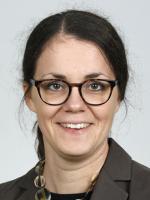
University Assistant Professor
Research interests
The Webster group focuses on catalysis with first row transition metals, with a focus on iron catalyst design for the synthesis of bonds between main-group elements. We are interested in trying to understand mechanism and in order to do so we use a varity of in situ and in-line techniques.
Watch Dr Webster discuss her research
Publications
Iron Catalyzed Double Bond Isomerization: Evidence for an FeI /FeIII Catalytic Cycle.
Chemistry A European Journal
(2021)
27
5972
(doi: 10.1002/chem.202004980)
Amine–Boranes as Transfer Hydrogenation and Hydrogenation Reagents: A Mechanistic Perspective
Angewandte Chemie International Edition
(2021)
60
14272
(doi: 10.1002/anie.202010835)
Heterobimetallic Complexes of 1,1-Diphosphineamide Ligands
Organometallics
(2021)
40
148
Room temperature iron catalyzed transfer hydrogenation usingn-butanol and poly(methylhydrosiloxane)
Green Chemistry
(2021)
23
2703
(doi: 10.1039/d0gc04175k)
Correction: Room temperature iron catalyzed transfer hydrogenation using n-butanol and poly(methylhydrosiloxane)
Green Chemistry
(2021)
23
3750
(doi: 10.1039/d1gc90042k)
Regioselective Alkyne Cyclotrimerization with an In Situ-Generated [Fe(II)H(salen)]·Bpin Catalyst
ACS Catalysis
(2020)
10
10157
(doi: 10.1021/acscatal.0c03068)
Seeking Heteroatom-Rich Compounds: Synthetic and Mechanistic Studies into Iron Catalyzed Dehydrocoupling of Silanes
ACS Catalysis
(2020)
10
6102
(doi: 10.1021/acscatal.0c01440)
Highly Sensitive Real-Time Isotopic Quantification of Water by ATR-FTIR.
Analytical Chemistry
(2020)
92
7500
(doi: 10.1021/acs.analchem.9b05635)
Hydrophosphination using [GeCl{N(SiMe3)2}3] as a pre-catalyst.
Chemical Communications
(2020)
56
13623
(doi: 10.1039/d0cc05792d)
Room Temperature Iron-Catalyzed Transfer Hydrogenation and Regioselective Deuteration of Carbon-Carbon Double Bonds
Journal of the American Chemical Society
(2018)
141
572
(doi: 10.1021/jacs.8b11553)
- ‹ previous
- Page 3

